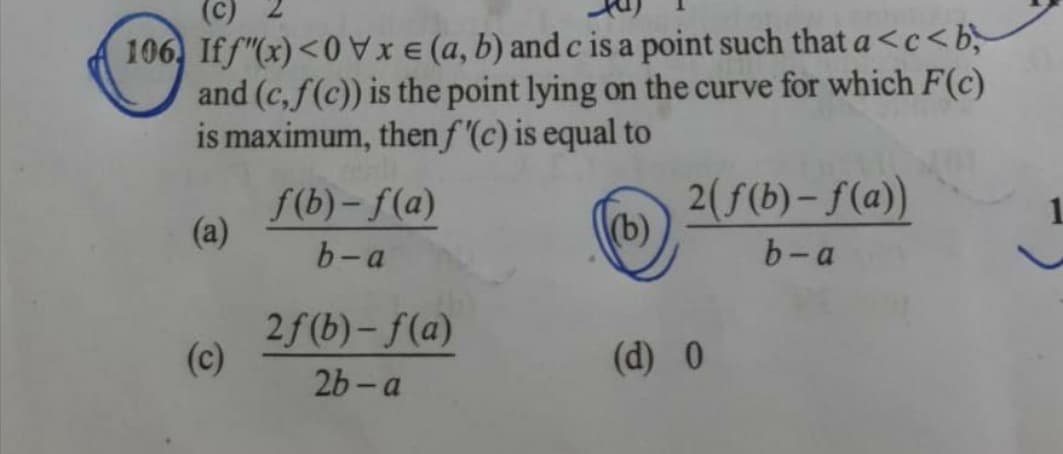106) Iff"(x) <0x € (a, b) and c is a point such that a and (c,f(c)) is the point lying on the curve for which F(c) is maximum, then f'(c) is equal to (a) (b) (c) f(b)-f(a) b-a 2f(b)-f(a) 2b-a 2(f(b)-f(a)) b-a (d) 0
106) Iff"(x) <0x € (a, b) and c is a point such that a and (c,f(c)) is the point lying on the curve for which F(c) is maximum, then f'(c) is equal to (a) (b) (c) f(b)-f(a) b-a 2f(b)-f(a) 2b-a 2(f(b)-f(a)) b-a (d) 0
Elementary Linear Algebra (MindTap Course List)
8th Edition
ISBN:9781305658004
Author:Ron Larson
Publisher:Ron Larson
Chapter6: Linear Transformations
Section6.CR: Review Exercises
Problem 41CR: For T:P4R5, and rank (T)=3, find nullity (T).
Related questions
Question

Transcribed Image Text:(C)
106) Iff"(x) <0Vxe (a, b) and c is a point such that a<c<b
and (c,f(c)) is the point lying on the curve for which F(c)
is maximum, then f '(c) is equal to
(a)
(c)
f(b)-f(a)
b-a
2f(b)-f(a)
2b-a
(b)
2(f(b)-f(a))
b-a
(d) 0
Expert Solution
This question has been solved!
Explore an expertly crafted, step-by-step solution for a thorough understanding of key concepts.
Step by step
Solved in 2 steps

Recommended textbooks for you

Elementary Linear Algebra (MindTap Course List)
Algebra
ISBN:
9781305658004
Author:
Ron Larson
Publisher:
Cengage Learning

Algebra & Trigonometry with Analytic Geometry
Algebra
ISBN:
9781133382119
Author:
Swokowski
Publisher:
Cengage

Elementary Linear Algebra (MindTap Course List)
Algebra
ISBN:
9781305658004
Author:
Ron Larson
Publisher:
Cengage Learning

Algebra & Trigonometry with Analytic Geometry
Algebra
ISBN:
9781133382119
Author:
Swokowski
Publisher:
Cengage